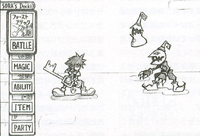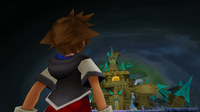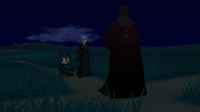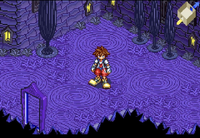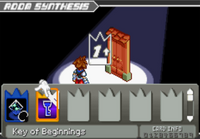Kingdom Hearts Chain of Memories
| Kingdom Hearts Chain of Memories | |
|---|---|
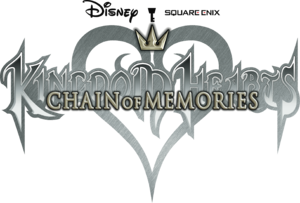
| |
| キングダムハーツ チェインオブメモリーズ Kingudamu Hātsu Chein obu Memorīzu | |
| Developer(s) | Jupiter |
| Publisher(s) |
|
| Release date(s) | |
| Genre | Action RPG |
| Game modes | Single player, two-player (Link Mode) |
| Ratings | ESRB: OFLC: G8+ |
| Platform(s) | Game Boy Advance |
- "Adventure is in the cards."
- —Tagline
Kingdom Hearts Chain of Memories is the second game in the Kingdom Hearts series. It is a direct sequel to Kingdom Hearts. It was published by Square Enix and developed by Jupiter, and it was released in 2004.
Chronologically, it takes place after Kingdom Hearts and during Kingdom Hearts 358/2 Days.
The game focuses on Sora, Donald, and Goofy making their way through Castle Oblivion, reliving their memories of Kingdom Hearts, but with a card-based battle system. Aspects of the storyline are essential to understanding Kingdom Hearts II and other later entries in the series.
The original 2D version of the game is exclusive to the Game Boy Advance. It received a 3D remake called Kingdom Hearts Re:Chain of Memories, available for PlayStation 2, which was later included as part of Kingdom Hearts HD 1.5 ReMIX on PlayStation 3 and PlayStation 4.
Development[edit]
After the success of the original Kingdom Hearts, a sequel was immediately put into production, which eventually released as Kingdom Hearts II. A direct sequel was always envisioned as taking place one year after Kingdom Hearts with the gap in time being left ‘blank’.[1] It was suggested to Nomura that he make a title for the Game Boy Advance which began as Kingdom Hearts Lost Memories[2] after hearing how children wished to play Kingdom Hearts on the Game Boy Advance.[3] The development and programming of the title was mainly handled by Jupiter, who added things to the game based on specifications from Nomura’s team. Pre-rendered videos featured in the game were also made possible by the company AM3, who created software to compress video files for use on a smaller cartridge.
The gameplay of the game was envisioned by Nomura as a means to explain why Sora was not as powerful in the then-upcoming Kingdom Hearts II and cards were used to explain his jumbled-up memories and abilities. Initially this card-based gameplay began as a more traditional card game before the team began to add more and more action elements resembling the first title.[4] Originally battles were initiated by selecting enemies with a cursor, but this was changed to allowing the player to attack them and begin battle in a 2D environment instead which made the action easier for the team to make.
The story of the game was handled by Daisuke Watanabe who had worked on the original Kingdom Hearts, his scenario was based on an initial outline given to him by Nomura. Because the game wasn’t going to be voiced, Watanabe was able to be less restrained with his writing for each character and wanted them to make an impact within a limited number of scenes.[5] Any voice acting in-game is limited to reused sounds from Kingdom Hearts and grunts for the Organization members voiced by development staff. The themes of the game were also inspired by Final Fantasy X-2: Last Mission, whose scenario was written by Watanabe.[6]
This game was first unveiled to the public alongside Kingdom Hearts II on September, 2003 during the Tokyo Game Show. A website was also created for the game. A playable demo was available in that year's Jump Festa, displaying all the gameplay changes but keeping the story a secret. The game finally released in Japan on November 11, 2004.
Story[edit]
Sora, Donald Duck, and Goofy walk down a long path that seemingly goes nowhere. They see Pluto and start to follow him. He leads them to a crossroads. While deciding which path to take, a mysterious man in a black cloak approaches Sora and speaks to him, but at that moment his words are incomprehensible. The paths become one that leads them to Castle Oblivion. The cloaked man appears as they enter the castle and gives them a Card. They use the card to proceed through the castle.
The first world they go to is Traverse Town, where they discover that Leon, Aerith, Yuffie, and Cid have forgotten all about them. Strangely, though, they remember Sora, Donald, and Goofy's names, with Yuffie even mentioning that her heart still holds memories of them, even if her head doesn't. After Leon gives Sora a tutorial on fighting and gives Sora a summon card, they leave Traverse Town.
The cloaked man from before appears once more after they arrive on the next floor, but a second cloaked man also appears and introduces himself as Axel, challenging Sora to battle. Sora fends him off and is given more World Cards, and as Sora, Donald, and Goofy go through each floor, they relive their memories, all of which are somehow distorted in a different way, and begin to lose their original memories. By piecing together their distorted memories, they eventually discover that a Nobody, Naminé, has been reorganizing their memories at the orders of Marluxia, the Nobody who led them to the castle, in order to put herself in Kairi's place within Sora's memories and thus make him more compliant to the control of the Nobodies. As he makes his way to the peak of the castle, Sora slays the Organization members Larxene and Vexen, as well as defeating the Riku Replica created by Vexen and similarly reprogammed by Naminé to be loyal to her.
Meanwhile, Riku chooses to reject the peaceful sleep of the Realm of Darkness and is pulled through a Corridor of Darkness to the basement of the castle. He makes his way through the castle with the assistance of King Mickey Mouse, while fending off the temptations of Ansem, who has left a piece of himself within Riku's heart and wants Riku to return to being his host, as well as repelling attacks from Vexen, Lexaeus, Zexion, and their Riku Replica, who want to use Riku as a weapon to counter Marluxia's use of Sora. Along the way, Riku discovers that not all of Ansem's temptations were actually made by Ansem—some were instead made by DiZ, who was disguising himself as Ansem in order to test Riku's resistance to darkness.
At the end of the journey, Sora puts an end to Marluxia, freeing Naminé and the Riku Replica. Due to the damage done to Sora's memories, Naminé offers to restore his memories, although it means he will forget everything in the castle and will take a long time. Sora, Donald, and Goofy agree to this and go to rest in pods provided by Naminé.
The Riku Replica instead chooses to reject its given memories entirely, and leaves to find his own purpose. Desperate to prove that he is his own person, he is persuaded by Axel to slay Zexion in order to take his power and become something that the original Riku is not, but he is disappointed when it doesn't make him feel any different. Riku, following advice from DiZ to seek Naminé, runs into his Replica at the Twilight Town basement, and in a rage the Replica challenges Riku to a fight to the death. Riku wins, and tries to comfort his suffering Replica as the Replica fades away. Afterward, Riku finds Naminé and is shown Sora's situation. Naminé offers to manipulate Riku's memories in order to lock Ansem's phantom away, but Riku declines and instead chooses to confront Ansem directly. When he emerges from the basement, DiZ presents him with a black coat to protect him from the darkness and so the Organization won't be able to track him down. He also gives him a World Card to summon forth Ansem from his heart in order to defeat him.
After defeating Ansem, Riku and Mickey go to the crossroads outside the castle, where DiZ appears once again to ask if Riku will be following the road to light or the road to darkness. Instead, Riku chooses the middle road, "to dawn".
A year later, Roxas waits on top of the clock tower at Twilight Town.
Gameplay[edit]
Kingdom Hearts Chain of Memories follows a totally new battle system as well as gameplay. Now on the Game Boy Advance; exploration and platforming is conducted via an isometric view of the environment, while battles take place in a 2.5D plane. Much like Kingdom Hearts, Sora is able to manuever and platform around the environment in various worlds, though unlike before the rooms in each world are created by the player using special cards that affect not only the layout of the room but the enemies inside. Enemy heartless can appear in most worlds, though when the player strikes them they are transported to a separate arena to conduct the battle. The battle system similarly utilises cards representative of Sora's memories and abilities being jumbled up. Players rotate through their card deck while in battle, selecting a card causes Sora to use an attack animation which can be chained into a combo. At the end of a battle Sora obtains a mixture of Experience and currency known as Moogle Points, as well as a random Map Card.
Enemies also utilise their own cards during battle, which appear on the right-hand side of the screen, though their entire deck is hidden to the player and they can only see the card they are about to use, which then appears in the bottom-centre of the screen.
Card system[edit]
Sora can use any available card besides map cards to create up to three decks as long as there is at least one Attack Card in his deck and the player doesn't exceed the limit currently available to them, which is known as Card Points (CP). Cards can be obtained from interacting with the environment, through randomised packs purchased from Moogle Rooms or after battles and scripted events. Each card has a number from 0 to 9. This is known as Card Value. When a card is played against the enemy's card, the card with the lower value "Breaks" and is discarded. This leaves enemies vulnerable for a few seconds. Cards with a value of 0 can break any attack, but can be broken by any card if played too early. Using a card during a battle renders it unusable again, unless Sora uses the reload ability to reload the entire deck. Each time Sora uses this however the time it takes to reload increases, causing Sora to need to stand still longer up to triple the length of the first reload.
Other than using Attack, Magic/Summon, and Items cards, Sora can also use Premium cards, which are special Attack or Magic cards. These cards do not require as much CP to equip although they can become unreloadable cards when used, with the minor exception as the second or third card in a combo.
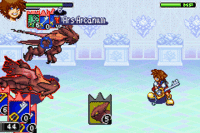
Combos & Sleights[edit]
Cards can be combined into sets of three, not only creating a higher value combo that is more difficult to break, but is also essential in activating sleights. The cost of combining cards is that the first card used in the combo cannot be reloaded when the deck is reloaded, although certain items, such as Elixir and Megalixir, can reload any unreloadable cards. When a combo of cards does not result in a sleight, Sora will do a combo attack that utilises the cards in the combo. For example if Sora combines two attack cards and a fire magic card, he will do two swings with the Keyblade and then finish with a blast of Fire.
If the total strength of the cards used in the combo add up to a specific amount, and are of the correct type however, Sora can utilise powerful abilities known as Sleights. These can be learned after leveling up or obtained from boss fights and chests. These powerful abilities can be ones he previously utilised in Kingdom Hearts such as Sonic Blade, Strike Raid and Ars Arcanum. Though additional sleights new to the series were also added, such as Fire Raid or Lethal Frame.
Card types[edit]
- Attack Cards - The most common way to attack, as the name suggests. These are depicted by different types of Keyblades and have red borders.
- Magic Cards - Unleashes magic spells, such as Fire, Ice, Thunder, Cure, and Gravity. These have blue borders.
- Summon Cards - Calls forth an allied character such as Simba or Genie to attack or assist. These also have blue borders.
- Item Cards - Used to restore attack cards or magic cards with Potions or Ethers, respectively. These can only be used once per battle, and have green borders.
Special cards[edit]
There are three types of cards that are different from the other cards in battle:
- Friend Cards - Appear in the battlefield at certain times for pickup and can summon an ally to help fight. These have green borders, like Item cards.
- Enemy Cards - Based on enemies or bosses and can temporarily give Sora (or Riku) better offensive or defensive capabilities. These have black borders, and cannot be used in sleights.
- Gimmick Cards - Gimmick cards only appear during certain boss battles. Unique attributes of these cards is that they are always green, the card value is always 0, and the picture on the card is a green Mickey Mouse insignia, like the keychain attached to the Keyblade. When used, the colors on the screen inverse, and the boss is either stunned, or the battle area changes allowing you to gain the upper hand. Due to their card value, they always break the enemy's attacks, and their effect prevents the boss from attacking until it is completed.
Map Cards[edit]
In order to traverse the rooms within each world, the player must use map cards to create them. These cards are generally obtained after a battle and have a value from 0 to 9. When approaching a door to another room, the player must use a map card that meets a specific number value or type. The cards used to create rooms will have effects on both the enemies encountered, and the layout of the room itself. These effects can range from decreasing the value of enemy cards, increasing the likelihood of Friend Cards appearing or creating a Save Point. Much like cards used in battle, map cards have differently coloured borders denoting their effects, red affects enemies, green affects the player and blue creates rooms free from enemy encounters.
Reverse/Rebirth mode[edit]
After completing the game as Sora, a new challenge arises. Reverse/Rebirth mode follows Riku as he climbs the basements of Castle Oblivion. Riku gets a World Card for each of the worlds Sora goes through except 100 Acre Wood. Riku's deck cannot be changed; however, it changes automatically as time goes on. Riku does not need as much time to reload his deck. Certain enemy cards are only available to Riku, and then unlocked for Sora after completing the game with Riku. Riku can only keep the enemy cards that are based on the bosses after winning them during battle, the others are available in one world only.
Riku's gameplay[edit]
Instead of leveling up HP, CP or sleights, when Riku levels up, he can increase HP, AP (Attack Power), or DP (Dark Points). After Ansem, Seeker of Darkness (who is still alive) tempers the darkness in Riku's heart, Riku can use his dark powers during battle. These powers are triggered by taking damage or breaking his opponent's cards; when the Dark Points reach 30 or more, Riku will automatically go into Dark Mode. In Dark Mode, Riku can use 3 powerful sleights exclusive to his Dark Mode: Dark Aura, Dark Firaga, and Dark Break (these attacks were used by the Riku Replica in Sora's story). How long Dark Mode lasts depends on how much DP he has, and taking damage as well as being card broken reduces the amount of DP Riku has left in a given battle. When the DP counter reaches zero, Riku turns back into his original form. Dark Mode can be achieved any number of times in a given battle.
Riku does not have access to any of the friend cards that Sora had. Instead, he has King Mickey as his only friend card. Using Mickey heals Riku, reloads the deck, and stuns enemies for a few seconds. Using more Mickey cards at once increases the power of this attack. Because of his inability of using magic cards, Riku cannot heal as easily during battle, limiting it to the Oogie Boogie and Search Ghost enemy cards in addition to Mickey Mouse. Bosses exclusive to Riku's story are: Lexaeus, and Ansem, Seeker of Darkness.
Link mode[edit]
With the use of a Game Link Cable, an additional multiplayer mode can be played, where two players battle each other. Decks are loaded from save files of Sora's story. The player controls Sora while the opponent is depicted as similar to AntiSora, although the difference between the two is only cosmetic. Different worlds can be chosen to determine the arena's background. Both players can see each other's battle cards to some extent, though this effect can be blocked with the Darkball enemy card.
Worlds and characters[edit]
|
Kingdom Hearts Re:Chain of Memories[edit]
Kingdom Hearts Re:Chain of Memories is a PlayStation 2 remake of the game, featuring 3-D graphics and voice-acting, along with all-new cards and cutscenes. In Japan, it was released in 2007 exclusively in a package titled Kingdom Hearts II Final Mix+, and it was released individually in North America on December 2, 2008. The game was remastered in high definition and released as part of Kingdom Hearts HD 1.5 ReMIX for PlayStation 3, making it available in Europe and Australia for the very first time as part of the collection. It was later ported to PlayStation 4 as part of Kingdom Hearts HD 1.5 + 2.5 ReMIX.
Notes and references[edit]
- ^ GMR Magazine 2004; Tetsuya Nomura: "Initially, we weren’t planning on telling the story of that one “blank” year, but the more we started discussing the GBA version, the more we thought it would be to do so in Chain of Memories."
- ^ Kingdom Hearts Chain of Memories Ultimania; When we look at the project book we can see that KH: CoM was originally called "KH: Lost Memories". / Tetsuya Nomura: "Though for some we had to change the title you'll notice it isn't that much different than the original.. I thought that "Chain of Memories" had more style and it matched the general outline of the story too"
- ^ Kingdom Hearts Chain of Memories Ultimania; What was the reason you decided to develop this installment for the GBA? / Tetsuya Nomura: Soon after the release of the previous installment, I was told that I should make a KH for GBA. But at the time I was skeptical of the idea of seeing KH in 2D and said "Can't do it". Then as I began to think about what I could work on next, I began to hear "Our kid wants to play KH on GBA" alot more frequently. That kind of real voice that was saying that "Kids want to play" got me seriously considering it.
- ^ Kingdom Hearts Chain of Memories Ultimania; Yuichi Kanemori: "When we started development, it was just a card game that had taken on the series aesthetic and story."
- ^ Kingdom Hearts Chain of Memories Ultimania; Daisuke Watanabe: "But since we couldn't rely on voice actors' performances this time, we had nothing but the letters of the words themselves to convey the characters.I had no choice but to write with abandon instead."
- ^ Kingdom Hearts Chain of Memories Ultimania: The scenario you wrote for FFX-2 Last Mission was interwoven with a theme that was something like: even if things aren't going well right now, the fun moments from the past are solid, and they won't fade. I feel like it works here too. / Daisuke Watanabe: You're absolutely correct. That feeling of happiness from having met someone - even if it is based on lies or misunderstanding, the fact that you were happy was still real. To be unwavering about the truth here and reject the happiness you felt as "fake" is sad, I think."
